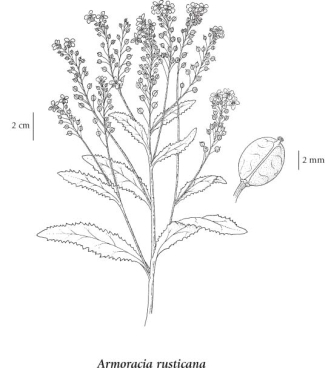Armoracia rusticana G. Gaertn., B. Mey. & Scherb.
common horseradish (horseradish)
Brassicaceae (Mustard family)
Introduction to Vascular Plants
common horseradish (horseradish)
Brassicaceae (Mustard family)
Introduction to Vascular Plants
Species Information
General:
Perennial herb from a deep, swollen, spongy root; stems often branched, 0.6-2.0 m tall, glabrous.
Leaves:
Basal leaves long-stalked, 30-50 cm long, widely egg-shaped to oblong, toothed; stem leaves stalked and unstalked; lower stem leaves like basal ones, middle and upper stem leaves often lobed.
Flowers:
Inflorescence a flat-topped cluster; petals white, short-clawed, 5-7 mm long.
Fruits:
Silicles, about 3 mm wide, flattened perpendicular to the partitions, styles about 0.3 mm long; seeds 4-6 per chamber.
Illustration

If more than one illustration is available for a species (e.g., separate illustrations were provided for two subspecies) then links to the separate images will be provided below. Note that individual subspecies or varietal illustrations are not always available.
Illustration Source: The Illustrated Flora of British Columbia
Ecology
Ecological Framework for Armoracia rusticana
The table below shows the species-specific information calculated from
original data (BEC database) provided by the BC Ministry of Forests and Range.
(Updated August, 2013)
The table below shows the species-specific information calculated from
original data (BEC database) provided by the BC Ministry of Forests and Range.
(Updated August, 2013)
| Site Information |
Value / Class |
||
|
Avg |
Min |
Max |
|
| Elevation
(metres) |
1125 | 1110 | 1140 |
| Slope
Gradient (%) |
2 | 0 | 5 |
|
Aspect (degrees) |
239 | 240 | 240 |
| Soil
Moisture Regime (SMR) [0 - very xeric; 4 - mesic; 8 - hydric] |
6 | 6 | 6 |
| Modal
Nutrient Regime
Class |
D | ||
| #
of field plots species was recorded in: |
2 | ||
| Modal
BEC Zone Class |
SBS | ||
|
All BEC Zones (# of stations/zone) species was recorded in |
SBS(2) | ||
|
Source:
Klinkenberg 2013
|
|||
Habitat and Range
Moist ditches and disturbed areas in the lowland, steppe and montane zones; rare garden escape in S BC; introduced from Eurasia.Status Information
Synonyms
Synonyms and Alternate Names:
Armoracia armoracia (L.) Britt.
Armoracia lapathifolia
Cochlearia armoracia L.
Nasturtium armoracia (L.) Fries
Radicula armoracia (L.) B.L. Robins.
Rorippa armoracia (L.) A.S. Hitchc.